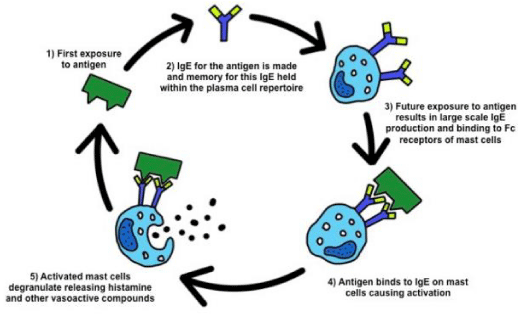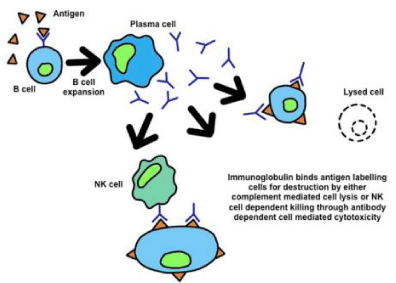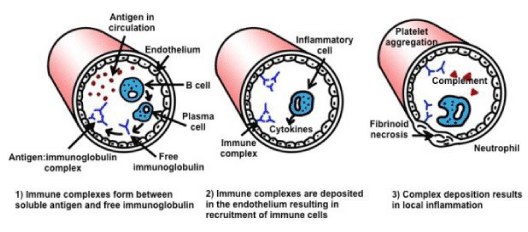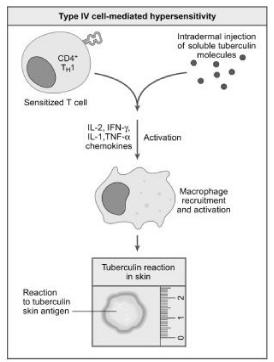Hypersensitivity Reaction: Review
Shimels Tikuye Yalew*
Animal Biotechnology Research Program, National Agricultural Biotechnology Research Centre, Ethiopian Institute of Agricultural Research, Holetta, Ethiopia
*Address for Correspondence: Shimels Tikuye Yalew, Animal Biotechnology Research Program, National Agricultural Biotechnology Research Centre, Ethiopian Institute of Agricultural Research, Holetta, Ethiopia, Tel: + 251-913-796-389; E-mail: [email protected]
Submitted: 05 August 2020; Approved: 11 August 2020; Published: 13 August 2020
Citation this article: Yalew ST. Hypersensitivity Reaction: Review. Int J Vet Sci Technol. 2020;4(1): 028-032.
Copyright: © 2020 Yalew ST. This is an open access article distributed under the Creative Commons Attribution License, which permits unrestricted use, distribution, and reproduction in any medium, provided the original work is properly cited
Keywords: Hypersensitivity; Type I hypersensitivity; Type II hypersensitivity; Type III hypersensitivity; Type IV hypersensitivity
Download Fulltext PDF
Hypersensitivity is an adaptive immune response which occurs in an inappropriate or exaggerated way, resulting in tissue damage or some other detrimental response in the host. There are four types of hypersensitivities those are types I, II and III are antibody mediated and type IV is cell mediated. Type I hypersensitivity (immediate hypersensitivity) involves the production of allergen specific IgE which binds to mast cells and causes their degranulation. Type II hypersensitivity reaction involves antibodies of class IgM & IgG, and results in the damage or destruction of cells or tissues. Type III hypersensitivity is mediated by the deposition of immune complexes in blood vessels and tissues. Type IV hypersensitivity is mediated by T cells and macrophages (and their cytokines). Minimizing exposure to potential antigens reactions may decrease the developing of the diseases.
Abbreviations
ADCC: Antibody Dependent Cell mediated Cytotoxicity; Ag-ab complex: Antigen Antibody Complex; DNFB: Dinitrofluorobenzene; DTH: Delayed type hypersensitivity; ELISA: Enzyme Linked Immunosorbent Assay; IgE: Immunoglobulin E; IgG: Immunoglobulin G; IgM: Immunoglobulin M; MHC: Major Histocompatibility Complex; RBC: Red Blood Cell; Rh-: Rhesus negative; Rh+: Rhesus positive
Introduction
Hypersensitivity refers to excessive, undesirable (damaging, discomfort-producing and sometimes fatal) reactions produced by the normal immune system. Hypersensitivity reactions require a pre- sensitized (immune) state of the host. Immune response recruits and mobilizes a series of effector molecules that induce a localized inflammatory response, which ultimately removes the antigen [1].
This inflammatory response usually does not extensively damage the host tissues. But under certain conditions, the inflammatory response produces deleterious effects, resulting in significant tissue damage or even death; this is termed as hypersensitivity. Hypersensitivity reactions can be divided into four types: type I, type II, type III and type IV, based on the mechanisms involved and time taken for the reaction [2].
Type I hypersensitivity is mediated by IgE and the reaction takes 15-30 minutes from the time of exposure to the antigen. Sometimes the reaction may have a delayed onset. The primary cellular component in this hypersensitivity is mast cell or basophil. The reaction is amplified and/or modified by platelets, neutrophils and eosinophils. The mechanism of reaction involves preferential production of IgE, in response to certain antigens, allergens. Diagnostic tests for immediate hypersensitivity include skin (prick and intradermal) tests, measurement of total IgE and specific IgE antibodies against the suspected allergens [3].
Type II hypersensitivity reaction involves antibody mediated destruction of cells. It is also known as cytotoxic reaction. In this hypersensitivity reaction, specific antibody (IgG or IgM) bound to cell surface antigen and destroy the cell. When antibody binds to antigen (microorganism or RBC) they form Ag-ab complex. When complement is activated on the surface of cell (RBC) it causes lysis of cell [4].
Type III hypersensitivity reaction is also known as immune complex hypersensitivity. The reaction may take 3-10 hours after exposure to the antigen. Type III hypersensitivity is associated with responses to soluble antigens that are not combined with host tissues but with antibodies in the blood which can then lead to inflammatory responses [5].
Type IV hypersensitivity or Delayed hypersensitivity was originally characterized by its time course in which the reactions took 12-24 hours to develop and persisted for 2-3 days. The best known examples are reactions induced by injecting tuberculin protein into the skin of animals infected by Mycobacterium tuberculosis. Delayed hypersensitivity is dependent on the direct action of T cells which recognize antigen after it has been processed by antigen-presenting cells and presented as peptide fragments bound to the Major Histocompatibility Complex (MHC) molecules [6].
Therefore the objective of this review is to make an overview and to give brief notes on types of hypersensitivity.
Definition
Hypersensitivity is an immunological state in which the immune system “over-reacts” to foreign antigen such that the immune response itself is more harmful than the antigen [7].
Type I Hypersensitivity
It is also known as immediate or anaphylactic hypersensitivity. The reaction may involve skin (urticaria and eczema), eyes (conjunctivitis), nasopharynx (rhinorrhea, rhinitis), bronchopulmonary tissues (asthma) and gastrointestinal tract (gastroenteritis). The reaction may cause from minor inconvenience to death (Figure 1). The reaction takes 15-30 minutes from the time of exposure to the antigen [3].
Immediate hypersensitivity is mediated by IgE. The primary cellular component in this hypersensitivity is mast cell or basophil. The reaction is amplified and/or modified by platelets, neutrophils and eosinophils. A biopsy of the reaction site demonstrates mainly mast cells and eosinophils. The mechanism of reaction involves preferential production of IgE, in response to certain antigens, allergens. IgE has very high affinity for its receptor on mast cells and basophils. These reactions mediated by agents without IgE-allergen interaction are not hypersensitivity reactions, although they produce the same symptoms [8].
Diagnostic tests for immediate hypersensitivity include skin (prick and intradermal) tests, measurement of total IgE and specific IgE antibodies against the suspected allergens. Total IgE and specific IgE antibodies are measured by a modification of enzyme immunoassay (ELISA) [9]. Symptomatic treatment is achieved with antihistamines which block histamine receptors. Chromolyn sodium inhibits mast cell degranulation, probably, by inhibiting Ca++ influx [10].
Hyposensitization (immunotherapy or desensitization) is another treatment modality which is successful in a number of allergies, particularly to insect venoms and, to some extent, pollens. The mechanism is not clear, but there is a correlation between appearance of IgG (blocking) antibodies and relief from symptoms. Suppressor T cells that specifically inhibit IgE antibodies may play a role [11].
Mechanism of type I hypersensitivity
Immediate reaction is a quick release of preformed immunomodulators, known as mast cells degranulation. The allergen stimulates the induction of cd4+T cells. These T cells secrete cytokines that cause IgE production by plasma cells. The IgE molecule will bind to Fc receptor on mast cell and basophils which in turn causes vasodilation, increased vascular permeability and vascular spasm [13].
Type II Hypersensitivity
Type II hypersensitivity reaction involves antibody mediated destruction of cells. It is also known as cytotoxic reaction. In this hypersensitivity reaction, specific antibody (IgG or IgM) bound to cell surface antigen and destroy the cell as shown in figure 2. If the cell is microorganism, killing of cell is beneficial to host. However in Type II hypersensitivity, the cells are own RBC [4].
Mechanisms of killing cells
Complement mediated lysis of cell is a system of lytic enzyme which are usually inactive in blood. Enzymes of complement system are activated by antigen-antibody complex. When antibody binds to antigen (microorganism or RBC) they form Ag-ab complex. Ag-ab complex can activate complement system by three different mechanism-classical pathway, alternate pathway and lectin pathway. Activated complement proceeds in cascade mechanism. When complement is activated on the surface of cell (RBC) it causes lysis of cell [15].
Antibody Dependent Cell Mediated Cytotoxicity (ADCC) is when antibody binds with antigen by its Fab portion. However Fc region of antibody has receptor on cytotoxic cells. So, antibody cross link target cell (microorganism or RBC) with cytotoxic cells and promote killing. Most cytotoxic cells contain storage of hydrolytic and digestive enzymes. These enzymes are released on the surface of target cell (MOs or RB or target cell), killing them. Here antibody itself does not kill or destroy cell but rather mediate killing by presenting antigen to cytotoxic cell. Similarly cytotoxic cell depends upon antibody to bind antigen. So this mechanism is known as Antibody dependent cell mediated cytotoxicity [16].
When antigen enters into host body, antibodies are produced. Antibody binds to antigen through Fab region. Fc region of antibody remains free. Phagocytic cells such as Neutrophils, macrophages and monocytes have receptors that can bind to Fc region of antibody. The receptor is known as FcR. In this case antibody molecule directly cross links antigen (Microrganism or RBC or target cell) with phagocytic cells. This cross-linkage activates phagocytic cells and increases the rate of phagocytosis. This increased rate of phagocytosis by binding of antibody to antigen is called Opsonization [17].
Examples of diseases caused by type II hypersensitivity
Simplest form of cytotoxic reactions is seen after transfusion of ABO incompatible blood. As an example people with type O blood have in their circulation naturally occurring IgM anti A and anti B which react with the A and B blood group substances. If such persons were to be transfused with a unit of type A red cell, the antibodies can cause complement dependent lysis or phagocytosis of the transfused cell [18].
Rh incompatibility reactions is formed antibodies against Rh antigens can be damaging to new- born babies. In brief, a Rhesus negative (Rh-) mother may be immunized by the trans placental passage of red cells from the baby and may make antibodies against Rh+ cells of her (usually first) baby who has inherited the Rh antigen (or factor) from his father. Any subsequent Rh+ babies she might have may be damaged by these antibodies which can cross the placenta, bind to the baby’s erythrocytes, activate complement and lyse the cells causing anemia. Fortunately, this hemolytic disease of the new-born is now understood, and is controllable and can be largely avoided by preventing sensitization of the mother in the first place. This is done by a process known as passive immunization. Immediately after the birth of her first child, the mother is injected with anti-rhesus antibodies. These bind to any fetal erythrocytes that have entered her blood stream around the time of birth when the placenta was breaking down and bring about their destruction without them sensitizing her immunologically. The next baby to be conceived develops in an environment free of these damaging antibodies [19].
Type III Hypersensitivity
It is also known as immune complex hypersensitivity. The reaction may take 3-10 hours after exposure to the antigen. Type III hypersensitivities are mediated by IgG and IgM antibodies. Unlike a Type II response, Type III hypersensitivity is associated with responses to soluble antigens that are not combined with host tissues but with antibodies in the blood which can then lead to inflammatory responses. Under normal conditions circulating Ag/Ab complex is cleared by monocytes / microphages but excessive amount of antigen leads to overwhelming amount and deposition of immune complex (Ag-Ab) that monocytes fail to remove [5].
Mechanism of action
Immune complexes are generated in every antibody response. The pathogenic potential of immune complexes is determined in part by their size. Larger aggregates fix complement and are readily removed by phagocytes, while the small complexes that form at antigen excess tend to deposit in blood vessel walls of certain tissue sites, and it is here that they cause tissue damage or immunocomplex disease. Immune complexes can activate platelets and basophils via Fc receptors to release vasoactive amines which cause endothelial cell retraction and increased vascular permeability leading to complex deposition as shown in figure 3 [20].
Examples of type III hypersensitivity reactions
Arthus reaction is a skin reaction seen as an area of redness and swelling which is maximal 6 hours after intradermal injection of antigen. It is caused by IgG When a sensitized individual has IgG antibodies directed against an antigen immune complexes can be generated locally by injection of the antigen into the skin, IgG antibody that has diffused into the tissues forms immune complexes locally. The immune complexes creates a local inflammatory response by type III hypersensitivity reaction. This is called an Arthur reaction [4].
In the pre-antibiotic era, immune horse serum was often used to treat pneumococcal pneumonia. Specific antibodies in the horse serum would help the patient to clear the infection. However, such treatments also stimulate the immune system to make IgG antibody to the foreign serum proteins and after a period of time immune complexes form throughout the body. This is an unusual type of allergy; because serum proteins (the allergen) are given in large amounts and are long-lived, the sensitization and the allergic reaction both take place after only one dose of allergen [21].
In a number of infectious diseases such as malaria, leprosy, viral hepatitis and bacterial endocarditis, there may be times during the course of the infection when large amounts of antigen and antibodies exist simultaneously and cause the formation of immune aggregates that are deposited in various locations. Thus some of the symptoms of these diseases may include a component attributable to type III hypersensitivity [22].
Type IV Hypersensitivity
Delayed or type IV hypersensitivity was originally characterized by its time course in which the reactions took 12-24 hours to develop and persisted for 2-3 days. The best known examples are reactions induced by injecting tuberculin protein into the skin of animals infected by Mycobacterium tuberculosis and the contact hypersensitivity induced by exposure to reactive hapten such as Dinitrofluorobenzene (DNFB). These are monocytic inflammations mediated by T cells reacting with antigen. The mycobacteria have a strong adjuvant activity for inducing type IV hypersensitivity and many experimental studies have been conducted by sensitizing animals with a protein antigen in Freund’s complete adjuvant, which is an emulsion of mineral oil containing mycobacteria as shown in figure 4. Immunization without this type of adjuvant sensitizes for a hypersensitivity reaction with a faster onset and resolution. Delayed hypersensitivity is dependent on the direct action of T cells which recognize antigen after it has been processed by antigen- presenting cells and presented as peptide fragments bound to the Major Histocompatibility Complex (MHC) molecules. Delayed hypersensitivity reactions to protein antigens are found in some responses to proteins released in insect bites, but their clinical importance is primarily in transplantation reactions, responses to infectious agents, and some autoimmune diseases. Type IV hypersensitivity reactions also cause the skin lesions in viral diseases such as smallpox and measles. Cytokines produced by T cells may also be a significant stimulant for macrophages in rheumatoid synovial membrane to produce large quantities of TNFα [23].
Mechanism of action
Delayed Type Hypersensitivity (DTH) reactions are mediated by inflammatory CD4 T cells (Th1) that activate local inflammatory responses and by cytotoxic CD8 T cells that can kill tissue cells directly. Unlike immediate type hypersensitivity, DTH reactions appear 18-24 hours after antigenic challenge of a sensitized individual. As in other types of sensitivity reactions, DTH hypersensitivity consists of two main stages, namely, the sensitization stage and the challenge stage, which leads to the reaction [25].
Conclusion
Hypersensitivity refers to excessive, undesirable (damaging, discomfort-producing and sometimes fatal) reactions produced by the normal immune system. Hypersensitivity reactions require a pre- sensitized (immune) state of the host. Hypersensitivity reactions are common yet they aren’t often considered in treatment regimens. Untreated hypersensitivities can contribute to a myriad of conditions including autoimmune diseases. Ultimately, by minimizing exposure to potential antigens reactions may decrease the developing of the diseases.
Acknowledgement
My special thanks goes to my families who were behind the successes of my work. I thank you very much!!! God bless you!!!
- SM, Montoya MI. Allergic reactions. In Basic Clinical Anesthesia. Springer. 2015; 197- 202.
- Marc D, Olson K. Hypersensitivity reactions and methods of detection. NeuroScience Inc. 2009.
- Lawton S. Identifying, diagnosing and managing skin allergies. Primary Health Care. 2016; 26: 34. https://bit.ly/33X4i41
- Uzzaman A, Cho SH. Classification of hypersensitivity reactions. In allergy and asthma proceedings. Ocean Side Publications Inc. 2012; 33: 96-99. https://bit.ly/3fJOFis
- Baldo BA, Pham NH. Classification and descriptions of allergic reactions to drugs. In Drug Allergy. 2013; 15-35. https://bit.ly/2DRI0Wm
- Justiz VAA, Zulfiqar H, Ramphul K. Delayed hypersensitivity reactions. 2020. PubMed: https://pubmed.ncbi.nlm.nih.gov/30085565/
- Vaillant AAJ, Zito PM. Immediate hypersensitivity reactions. 2019
- Tran TP, Muelleman RL. Allergy, hypersensitivity, angioedema, and anaphylaxis. Rosen’s emergency medicine: Concepts and clinical practice. 8th Ed. Philadelphia, PA: Elsevier Saunders. 2014
- Hamilton RG, Adkinson NF. Clinical laboratory assessment of IgE-dependent hypersensitivity. Journal of Allergy and Clinical Immunology. 2003; 111: 687-701. DOI: https://doi.org/10.1067/mai.2003.123
- Rout M, Behera SK, Mohanta RK. Hypersensitivity reactions: The fulcrum of immunopathology. Journal of Immunology and Immunopathology. 2014; 16: 20-32.
- Gaur SN, Kumar R, Singh AB, Agarwal MK, Arora N. Guidelines for practice of allergen immunotherapy in India: 2017-An update. Indian Journal of Allergy Asthma and Immunology. 2017; 31: 3. https://bit.ly/3gNQMTG
- Todd I, Spickett G. Lecture Notes Immunology, 6th Ed. Oxford. Wiley-Blackwell. 2010. https://bit.ly/2DR4GWC
- Theoharides TC, Kempuraj D, Tagen M, Conti P, Kalogeromitros D. Differential release of mast cell mediators and the pathogenesis of inflammation. Immunological Reviews. 2007; 217: 65-78. https://bit.ly/3fKDRk1
- Chapel H, Haeney M, Misbah S, Snowden N. Essentials of clinical immunology, Includes Wiley E-Text, 6th Edition, WileyBlackwell. 2014. https://bit.ly/3kM44me
- Johnson AG, Clarke BL. High-Yield immunology. Lippincott Williams & Wilkins. 2005.
- Samson CM, Foster CS. Hypersensitivity: Antibody‐mediated cytotoxic (Type II). Wiley Online Library. 2001. https://bit.ly/2DSQyMv
- Lamm ME. Interaction of antigens and antibodies at mucosal surfaces. Annu Rev Microbiol. 1997; 51: 311-340. DOI: 10.1146/annurev.micro.51.1.311
- Brent L. A history of transplantation immunology. Academic Press. 1996. https://bit.ly/30M0HDO
- Burstein RH, Blumenthal HT. Vascular lesions of the placenta of possible immunogenic origin in erythroblastosis fetalis. American Journal of Obstetrics and Gynaecology. 1962; 83: 1062-1068. https://bit.ly/30OfEFm
- Hoiby N, Doring G, Schiotz PO. The role of immune complexes in the pathogenesis of bacterial infections. Annual Reviews in Microbiology. 1986; 40: 29. https://bit.ly/33SLGlE
- Casadevall A, Dadachova E, Pirofski L. Passive antibody therapy for infectious diseases. Nature Reviews Microbiology. 2004; 2: 695. https://go.nature.com/2PK9akv
- Barnett EV, Knutson DW, Abrass CK, Chia DS, Young LS, Liebling MR. Circulating immune complexes: their immunochemistry, detection, and importance. Annals of Internal Medicine. 1979; 91: 430440. https://bit.ly/3iC52j3
- Crowle AJ. Delayed hypersensitivity in the mouse. In Advances in immunology. 1975;
- 20: 197-264. https://bit.ly/2DYnpzn
- Jeffrey KA. Introductory Immunology: Basic concepts for Interdiscipilinary Applications. 2019. DOI https://doi.org/10.1016/C2018-0-00337-0
- Posadas SJ, Pichler WJ. Delayed drug hypersensitivity reactions-new concepts. Clin Exp Allergy. 2007; 37: 989-999. DOI: 10.1111/j.1365-2222.2007.02742.x





Sign up for Article Alerts